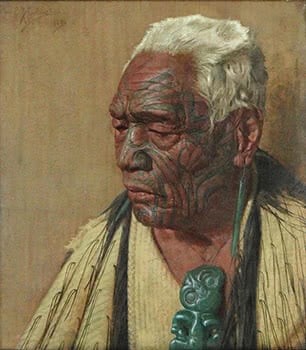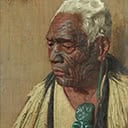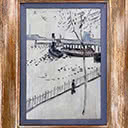Wharekauri Tahuna, A Chieftain of the Arawa Tribe
47 x 41.5 cm
est. $500,000 - 750,000
Provenance:
Olive Goldie Collection - Artist's Wife.
Lot 115, Webb's Fine Paintings & Jewellery, July 1985, illustrated p. 54.
Private Collection, Auckland
Reference:
p. 120,121, 141
C F Goldie, His Life & Painting Alister Taylor & Jan Glen, Martinborough 1977
Goldie's portraits of Maori are celebrated for their ability to realistically capture the mana and likeness of his sitters. This immortalised image of Wharekauri Tahuna, chief and tohunga of the Ngati-Manawa tribe, with full facial moko and greenstone adornments of his high status, does indeed embody both the mana of Wharekauri Tahuna and the skill of C F Goldie.
It is though that the two met in 1901, when Goldie visited Rotorua and asked local Maori to sit for him for the first time. Goldie painted a number of portraits of Wharekauri Tahuna over the course of his career and notably, this kaumatua was the subject of what is believed to have been the artist's last ever portrait, completed in 1941. Though it was not unusual for Goldie to paint multiple portraits of individuals with whom he had maintained good relationships, the significance of his connection and friendship with Wharekauri as one which bookended his artistic journey with Maori must not be understated.
The 7 foot tall Wharekauri was a mightily impressive warrior and an inspiring subject for Goldie. He was one of the 1,600 warriors who made the full fighting strength of the Te Arawa against Te Tumu pa, the Ngai-te-Rangi stronghold on the coastal sandhills between Tauranga and Maketu. In later life he became a recluse living in the Kai Mokopuna range. He was bought back to Murupara Pa to die at age 102. Whakakauri Tahuna's ancestral connection ties with Te Arawa, the Ngaiti Manawa tribal canoe which sailed across the Pacific arriving in New Zealand c. 1530.
When two Goldie paintings depicting Wharekauri and Atama Paparangi were accepted for the Paris Salon in 1935, the works (and, by association, his sitters) aroused great interest. Newspaper reviews meditated on the character of Wharekauri including his tohunga status. Wharekauri and Atama were described as the finest natives of which he has any records and Wharekauri (with the exception of one other subject) as the most fully tattooed Maori Goldie has ever painted.
The history of Te Arawa waka and Wharekauri's iwi, the replication and dissemination of his identity nationally and internationally, and the artist's decision to repeatedly draw artistic life from photographs of this last of the tohungas all inform this magnificent painting. Depicted in profile with his eyes downcast, the work untethers Wharekauri from any single moment in time to establish him within the collective consciousness of Aotearoa and his descendants.





